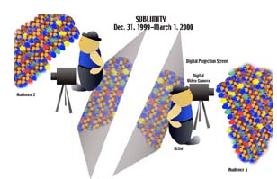DD: A complex question deserving a more complex answer than I have the time and space for here. Basically, we have seen fitful starts toward my ideal. In 1977, the very year that essay was published, which began as a lecture at the Long Beach Museum in 1975 or 1976, we saw some roaring beginnings, most of which I found myself involved with. On December 29, 1976, with the support of the Contemporary Arts Museum in Houston, I performed "Seven Thoughts" in the empty Houston Astrodome. In the last ten minutes of this 30-minute piece, I spoke up from the floor of the dome to the orbiting satellite above and sent the thoughts, one by one, to every IntelSat station on earth. It was probably the first use of the satellite by a single person for artmaking purposes. To the best of my knowledge only one nation, india, allowed the thoughts to be heard over radio. But the point was not to reach a big audience. The point was to do it at all...And let the news get out (that long-distance broadcasting was not an exclusive preserve of tv networks, armies, and governments). In february of 1977, I did another performance at the Whitney Museum of Art, "Four places two figures one ghost," which was simultaneously cablecast to a large live audience outside the walls of the museum. Again this may have been the first time this happened. Finally, as you know, in July of 1977, Joseph Beuys, Nam June Paik and I performed live at Documenta 6 and were broadcast by West German tv to many countries, including the old USSR... The first time visual artists produced a global telecast. I had "the last 9 minutes" of that show, which was also the title of a piece, the content of which I can't possibly go into here. As I can't for the other two mentioned above. In that year we saw several collaborations by artists like Keith Sonnier, Willoughby Sharp and others that sent video signals across distant points, often outside the traditional art support system--but the system knew it was happening. Since that year, we have seen museums evolve fitfully to the point where they now think of television--and most of all websiting--as an irregular but normal function to undertake. Most of the time, however, the content is essentially documentary, or second-hand. The broadcasts are essentially coverage of traditional exhibitions and traditional media. Not that this necessarily forces the content into non-revolutionary modes: I could have imagined an unsettling broadcast motivated by Jackson Pollock's paintings at MoMa in 1998, or the Alexander Rodchenko exhibition in the same year. It didn't happen, but it might have happened. It would be naive of me to claim that museums are now determined to reach that alienated audience I spoke of in the 70's. But they certainly know how to do it, now. And the web makes it not only easy but quite inexpensive. My instinct is that "the museum of the third kind" (title of an essay I am working on, soon to be finished, based on the Victoria and Albert lecture in 1997) is not going to be created by a set of museum trustees plus staff...But by a lone, mad individual or two, followed by the rest of us.

